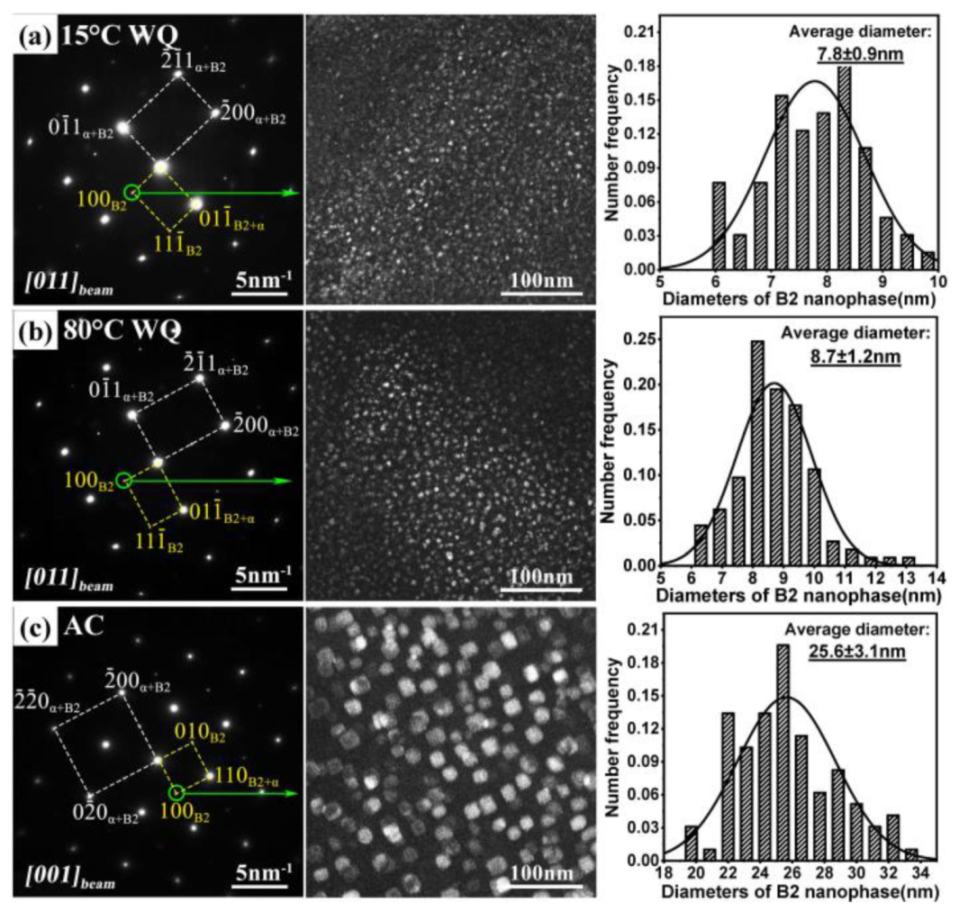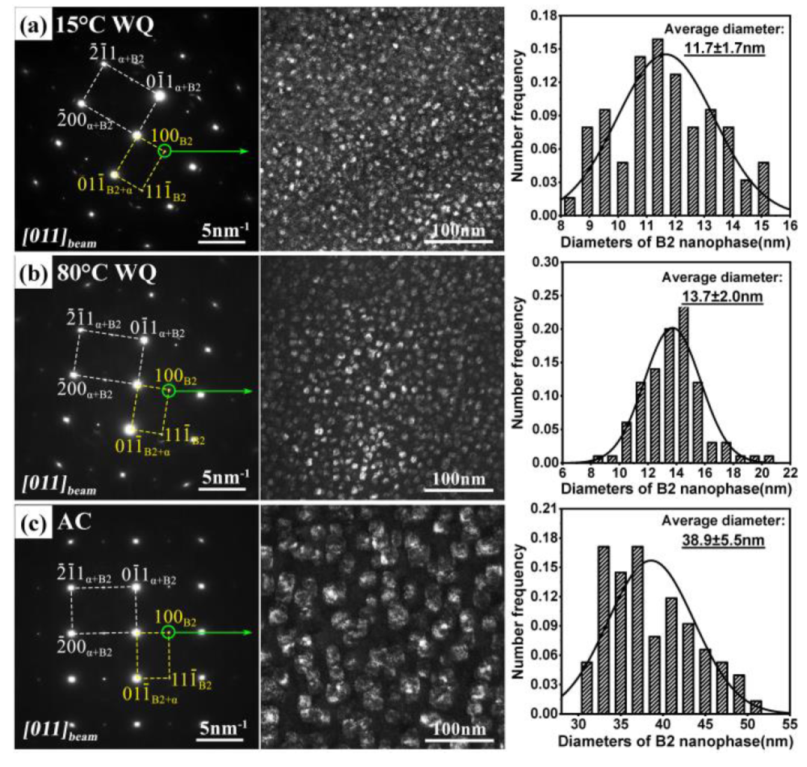Effect of Mo Alloying on the Precipitation Behavior of B2 Nano-Particles in Fe-Mn-Al-Ni Shape Memory Alloys
Abstract
:1. Introduction
2. Materials and Methods
3. Results
3.1. Microstructures of Fe-Mn-Al-Ni-Mo SMAs
3.2. Precipitation Behavior of B2 Nano-Particles in Fe-Mn-Al-Ni-Mo SMAs
3.3. Effect of Aging Treatment on Vickers Hardness in Fe-Mn-Al-Ni-Mo SMAs
4. Discussion
5. Conclusions
- (1)
- The formation of the γ phase was completely suppressed even under AC, but the intragranular cracks were generated after 15 °C WQ in both two Fe-Mn-Al-Ni-Mo SMAs;
- (2)
- B2 nano-particles were precipitated during the cooling process, and their sizes increased as the cooling rates decreased in both two Fe-Mn-Al-Ni-Mo SMAs;
- (3)
- The misfits between B2 nano-particles and α matrix increased with coarsening the B2 nano-particles in both two Fe-Mn-Al-Ni-Mo SMAs;
- (4)
- After natural aging for 338 days, all the Vickers microhardness increased in the 15 °C water-quenched 6Ni2Mo and 8Ni2Mo alloys subjected to aging at 200 °C for different times. It indicated that the precipitation of B2 nano-particles during natural aging was not suppressed by the Mo alloying in the Fe-Mn-Al-Ni SMAs.
Author Contributions
Funding
Data Availability Statement
Conflicts of Interest
References
- Jani, J.M.; Leary, M.; Subic, A.; Gibson, M.A. A review of shape memory alloy research, applications and opportunities. Mater. Des. 2014, 56, 1078–1113. [Google Scholar] [CrossRef]
- Chen, H.Y.; Wang, Y.D.; Nie, Z.H.; Li, R.G.; Cong, D.Y.; Liu, W.J.; Ye, F.; Liu, Y.Z.; Cao, P.Y.; Tian, F.Y.; et al. Unprecedented non-hysteretic superelasticity of [1]-oriented NiCoFeGa single crystals. Nat. Mater. 2020, 19, 712–718. [Google Scholar] [CrossRef] [PubMed]
- Li, S.H.; Cong, D.Y.; Sun, X.M.; Zhang, Y.; Chen, Z.; Nie, Z.H.; Li, R.G.; Li, F.Q.; Ren, Y.; Wang, Y.D. Wide-temperature-range perfect superelasticity and giant elastocaloric effect in a high entropy alloy. Mater. Res. Lett. 2019, 7, 482–489. [Google Scholar] [CrossRef] [Green Version]
- Hao, S.J.; Cui, L.S.; Jiang, D.Q.; Han, X.D.; Ren, Y.; Jiang, J.; Liu, Y.N.; Liu, Z.Y.; Mao, S.C.; Wang, Y.D.; et al. A Transforming Metal Nanocomposite with Large Elastic Strain, Low Modulus, and High Strength. Science 2013, 339, 1191–1194. [Google Scholar] [CrossRef] [PubMed] [Green Version]
- Xiao, F.; Chen, H.; Jin, X.J.; Nie, Z.H.; Kakeshita, T.; Fukuda, T. Stress-induced reverse martensitic transformation in a Ti-51Ni (at%) alloy aged under uniaxial stress. Sci. Rep. 2018, 8, 6099. [Google Scholar] [CrossRef] [Green Version]
- Otsuka, K.; Ren, X.B. Physical metallurgy of Ti-Ni-based shape memory alloys. Prog. Mater. Sci. 2005, 50, 511–678. [Google Scholar] [CrossRef]
- Ren, X.B.; Otsuka, K. Origin of rubber-like behaviour in metal alloys. Nature 1997, 389, 579–582. [Google Scholar] [CrossRef]
- Wang, D.; Hou, S.; Wang, Y.; Ding, X.D.; Ren, S.; Ren, X.B.; Wang, Y.Z. Superelasticity of slim hysteresis over a wide temperature range by nanodomains of martensite. Acta Mater. 2014, 66, 349–359. [Google Scholar] [CrossRef]
- Ye, F.; Ma, T.Y.; Ren, S.; Xiao, A.D.; Liu, X.L.; Ji, Y.C.; Ren, X.B. Temperature invariable magnetization in Co-Al-Fe alloys by a martensitic transformation. Appl. Phys. Lett. 2018, 113, 172402. [Google Scholar] [CrossRef]
- Ma, Y.Q.; Yang, S.Y.; Liu, Y.; Liu, Y. The ductility and shape-memory properties of Ni-Mn-Co-Ga high-temperature shape-memory alloys. Acta Mater. 2009, 57, 3232–3241. [Google Scholar] [CrossRef]
- Yang, S.Y.; Omori, T.; Wang, C.P.; Liu, Y.; Nagasako, M.; Ruan, J.J.; Kainuma, R.; Ishida, K.; Liu, X.J. A jumping shape memory alloy under heat. Sci. Rep. 2016, 6, 21754. [Google Scholar] [CrossRef] [PubMed] [Green Version]
- Meng, X.L.; Sato, M.; Ishida, A. Structure of martensite in sputter-deposited (Ni,Cu)-rich Ti-Ni-Cu thin films containing Ti(Ni,Cu)(2) precipitates. Acta Mater. 2009, 57, 1525–1535. [Google Scholar] [CrossRef]
- Tong, Y.X.; Liu, Y.; Xie, Z.L.; Zarinejad, M. Effect of precipitation on the shape memory effect of Ti50Ni25Cu25 melt-spun ribbon. Acta Mater. 2008, 56, 1721–1732. [Google Scholar] [CrossRef]
- Wang, X.B.; Yu, J.Y.; Liu, J.W.; Chen, L.G.; Yang, Q.; Wei, H.L.; Sun, J.; Wang, Z.C.; Zhang, Z.H.; Zhao, G.Q.; et al. Effect of process parameters on the phase transformation behavior and tensile properties of NiTi shape memory alloys fabricated by selective laser melting. Addit. Manuf. 2020, 36, 101545. [Google Scholar] [CrossRef]
- Yan, H.L.; Zhang, Y.D.; Esling, C.; Zhao, X.; Zuo, L. Determination of strain path during martensitic transformation in materials with two possible transformation orientation relationships from variant self-organization. Acta Mater. 2021, 202, 112–123. [Google Scholar] [CrossRef]
- Cong, D.Y.; Rule, K.C.; Li, W.H.; Lee, C.H.; Zhang, Q.H.; Wang, H.L.; Hao, Y.L.; Wang, Y.D.; Huang, E.W. Confined martensitic phase transformation kinetics and lattice dynamics in Ni-Co-Fe-Ga shape memory alloys. Acta Mater. 2016, 110, 200–206. [Google Scholar] [CrossRef]
- Peng, H.B.; Chen, J.; Wang, Y.N.; Wen, Y.H. Key Factors Achieving Large Recovery Strains in Polycrystalline Fe-Mn-Si-Based Shape Memory Alloys: A Review. Adv. Eng. Mater. 2018, 20, 18. [Google Scholar] [CrossRef]
- Wen, Y.H.; Peng, H.B.; Raabe, D.; Gutierrez-Urrutia, I.; Chen, J.; Du, Y.Y. Large recovery strain in Fe-Mn-Si-based shape memory steels obtained by engineering annealing twin boundaries. Nat. Commun. 2014, 5, 4964. [Google Scholar] [CrossRef] [Green Version]
- Tanaka, Y.; Himuro, Y.; Kainuma, R.; Sutou, Y.; Omori, T.; Ishida, K. Ferrous polycrystalline shape-memory alloy showing huge superelasticity. Science 2010, 327, 1488–1490. [Google Scholar] [CrossRef]
- Xia, J.; Noguchi, Y.; Xu, X.; Odaira, T.; Kimura, Y.; Nagasako, M.; Omori, T.; Kainuma, R. Iron-based superelastic alloys with near-constant critical stress temperature dependence. Science 2020, 369, 855–858. [Google Scholar] [CrossRef]
- Omori, T.; Kainuma, R. Martensitic Transformation and Superelasticity in Fe–Mn–Al-Based Shape Memory Alloys. Shape Mem. Superelasticity 2017, 3, 322–334. [Google Scholar] [CrossRef] [Green Version]
- Omori, T.; Ando, K.; Okano, M.; Xu, X.; Tanaka, Y.; Ohnuma, I.; Kainuma, R.; Ishida, K. Superelastic effect in polycrystalline ferrous alloys. Science 2011, 333, 68–71. [Google Scholar] [CrossRef] [PubMed]
- Tseng, L.W.; Ma, J.; Hornbuckle, B.C.; Karaman, I.; Thompson, G.B.; Luo, Z.P.; Chumlyakov, Y.I. The effect of precipitates on the superelastic response of [100] oriented FeMnAlNi single crystals under compression. Acta Mater. 2015, 97, 234–244. [Google Scholar] [CrossRef] [Green Version]
- Ozcan, H.; Ma, J.; Karaman, I.; Chumlyakov, Y.I.; Santamarta, R.; Brown, J.; Noebe, R.D. Microstructural design considerations in Fe-Mn-Al-Ni shape memory alloy wires: Effects of natural aging. Scr. Mater. 2018, 142, 153–157. [Google Scholar] [CrossRef]
- Jiang, S.H.; Wang, H.; Wu, Y.; Liu, X.J.; Chen, H.H.; Yao, M.J.; Gault, B.; Ponge, D.; Raabe, D.; Hirata, A.; et al. Ultrastrong steel via minimal lattice misfit and high-density nanoprecipitation. Nature 2017, 544, 460–464. [Google Scholar] [CrossRef] [PubMed]
- Vollmer, M.; Segel, C.; Krooss, P.; Gunther, J.; Tseng, L.W.; Karaman, I.; Weidner, A.; Biermann, H.; Niendorf, T. On the effect of gamma phase formation on the pseudoelastic performance of polycrystalline Fe-Mn-Al-Ni shape memory alloys. Scr. Mater. 2015, 108, 23–26. [Google Scholar] [CrossRef]
- Zhao, Y.L.; Li, Y.R.; Yeli, G.M.; Luan, J.H.; Liu, S.F.; Lin, W.T.; Chen, D.; Liu, X.J.; Kai, J.J.; Liu, C.T.; et al. Anomalous precipitate-size-dependent ductility in multicomponent high-entropy alloys with dense nanoscale precipitates. Acta Mater. 2022, 223, 117480. [Google Scholar] [CrossRef]
- Moon, J.; Kim, S.; Jang, J.I.; Lee, J.; Lee, C. Orowan strengthening effect on the nanoindentation hardness of the ferrite matrix in microalloyed steels. Mater. Sci. Eng. A 2008, 487, 552–557. [Google Scholar] [CrossRef]
- Ma, J.; Hornbuckle, B.C.; Karaman, I.; Thompson, G.B.; Luo, Z.P.; Chumlyakov, Y.I. The effect of nanoprecipitates on the superelastic properties of FeNiCoAlTa shape memory alloy single crystals. Acta Mater. 2013, 61, 3445–3455. [Google Scholar] [CrossRef]
- Chen, S.W.; Miyahara, Y.; Nomoto, A. Crystallographic orientation dependence of nanoindentation hardness in austenitic phase of stainless steel. Philos. Mag. Lett. 2018, 98, 473–485. [Google Scholar] [CrossRef]
- Omori, T.; Iwaizako, H.; Kainuma, R. Abnormal grain growth induced by cyclic heat treatment in Fe-Mn-Al-Ni superelastic alloy. Mater. Des. 2016, 101, 263–269. [Google Scholar] [CrossRef]
- Vollmer, M.; Arold, T.; Kriegel, M.J.; Klemm, V.; Degener, S.; Freudenberger, J.; Niendorf, T. Promoting abnormal grain growth in Fe-based shape memory alloys through compositional adjustments. Nat. Commun. 2019, 10, 10. [Google Scholar] [CrossRef] [PubMed] [Green Version]
- Huang, P.; Peng, H.B.; Wang, S.L.; Zhou, T.N.; Wen, Y.H. Relationship between martensitic reversibility and different nano-phases in a FeMnAlNi shape memory alloy. Mater. Charact. 2016, 118, 22–28. [Google Scholar] [CrossRef]
- Peng, H.B.; Huang, P.; Zhou, T.N.; Wang, S.L.; Wen, Y.H. Reverse Shape Memory Effect Related to α → γ Transformation in a Fe-Mn-Al-Ni Shape Memory Alloy. Metall. Mater. Trans. A 2017, 48, 2132–2139. [Google Scholar] [CrossRef]
- Vollmer, M.; Krooß, P.; Karaman, I.; Niendorf, T. On the effect of titanium on quenching sensitivity and pseudoelastic response in Fe-Mn-Al-Ni-base shape memory alloy. Scr. Mater. 2017, 126, 20–23. [Google Scholar] [CrossRef]
- Cheng, W.C.; Lin, Y.C.; Liu, C.F. The fracture behaviors in an Fe-Mn-Al alloy during quenching processes. Mater. Sci. Eng. A 2003, 343, 28–35. [Google Scholar] [CrossRef]
- Chu, C.M.; Huang, H.; Kao, P.W.; Gan, D. Effect of alloying chemistry on the lattice constant of austenitic Fe-Mn-Al-C alloys. Scr. Metall. Mater. 1994, 30, 505–508. [Google Scholar] [CrossRef]
- Mitchell, R.J.; Preuss, M.; Hardy, M.C.; Tin, S. Influence of composition and cooling rate on constrained and unconstrained lattice parameters in advanced polycrystalline nickel-base superalloys. Mater. Sci. Eng. A 2006, 423, 282–291. [Google Scholar] [CrossRef]
- Mishima, Y.; Ochiai, S.; Suzuki, T. Lattice parameters of Ni(γ), Ni3Al(γ′) and Ni3Ga(γ′) solid solutions with additions of transition and B-subgroup elements. Acta Metall. 1985, 33, 1161–1169. [Google Scholar] [CrossRef]
- Kitabjian, P.H.; Nix, W.D. Atomic size effects in Ni-Al based solid solutions. Acta Mater. 1998, 46, 701–710. [Google Scholar] [CrossRef]
- Teng, Z.K.; Ghosh, G.; Miller, M.K.; Huang, S.; Clausen, B.; Brown, D.W.; Liaw, P.K. Neutron-diffraction study and modeling of the lattice parameters of a NiAl-precipitate-strengthened Fe-based alloy. Acta Mater. 2012, 60, 5362–5369. [Google Scholar] [CrossRef]
- Vasudevan, V.K.; Kim, S.J.; Wayman, C.M. Precipitation reactions and strengthening behavior in 18 wt pct nickel maraging steels. Metall. Trans. A 1990, 21, 2655–2668. [Google Scholar] [CrossRef]
- Tewari, R.; Mazumder, S.; Batra, I.S.; Dey, G.K.; Banerjee, S. Precipitation in 18 wt% Ni maraging steel of grade 350. Acta Mater. 2000, 48, 1187–1200. [Google Scholar] [CrossRef]







| Alloys | Chemical Compositions (at.%) | ||||
|---|---|---|---|---|---|
| Fe | Mn | Al | Ni | Mo | |
| 6Ni2Mo | 44.3 | 36.5 | 10.7 | 6.2 | 2.3 |
| 8Ni2Mo | 43.6 | 35.2 | 10.9 | 7.9 | 2.4 |
| Alloys | Cooling Methods | Average Diameters of B2 Nano-Particles (nm) | Lattice Constants (Å) | Misfits (%) | |
|---|---|---|---|---|---|
| α Matrix | B2 Nano-Particles | ||||
| 6Ni2Mo | 15 °C WQ | 7.8 | 2.942 | 2.932 | 0.34 |
| 80 °C WQ | 8.7 | 2.955 | 2.909 | 1.57 | |
| AC | 25.6 | 2.978 | 2.870 | 3.69 | |
| 8Ni2Mo | 15 °C WQ | 11.7 | 2.885 | 2.881 | 0.14 |
| 80 °C WQ | 13.7 | 2.939 | 2.895 | 1.51 | |
| AC | 38.9 | 2.906 | 2.814 | 3.22 | |
Publisher’s Note: MDPI stays neutral with regard to jurisdictional claims in published maps and institutional affiliations. |
© 2022 by the authors. Licensee MDPI, Basel, Switzerland. This article is an open access article distributed under the terms and conditions of the Creative Commons Attribution (CC BY) license (https://creativecommons.org/licenses/by/4.0/).
Share and Cite
Yong, L.; Zuo, Y.; Sun, L.; Peng, H.; An, X.; Wang, H.; Wen, Y. Effect of Mo Alloying on the Precipitation Behavior of B2 Nano-Particles in Fe-Mn-Al-Ni Shape Memory Alloys. Metals 2022, 12, 261. https://doi.org/10.3390/met12020261
Yong L, Zuo Y, Sun L, Peng H, An X, Wang H, Wen Y. Effect of Mo Alloying on the Precipitation Behavior of B2 Nano-Particles in Fe-Mn-Al-Ni Shape Memory Alloys. Metals. 2022; 12(2):261. https://doi.org/10.3390/met12020261
Chicago/Turabian StyleYong, Liqiu, Yang Zuo, Lixin Sun, Huabei Peng, Xuguang An, Hui Wang, and Yuhua Wen. 2022. "Effect of Mo Alloying on the Precipitation Behavior of B2 Nano-Particles in Fe-Mn-Al-Ni Shape Memory Alloys" Metals 12, no. 2: 261. https://doi.org/10.3390/met12020261
APA StyleYong, L., Zuo, Y., Sun, L., Peng, H., An, X., Wang, H., & Wen, Y. (2022). Effect of Mo Alloying on the Precipitation Behavior of B2 Nano-Particles in Fe-Mn-Al-Ni Shape Memory Alloys. Metals, 12(2), 261. https://doi.org/10.3390/met12020261






